1 Introduction to Quantitative Analysis
1.1 Seminar
1.1.1 Getting Started
Install R and RStudio on your computer by downloading them from the following sources:
- Download R from The Comprehensive R Archive Network (CRAN)
- Download RStudio from RStudio.com
1.1.2 RStudio
Let’s get acquainted with R. When you start RStudio for the first time, you’ll see three panes:
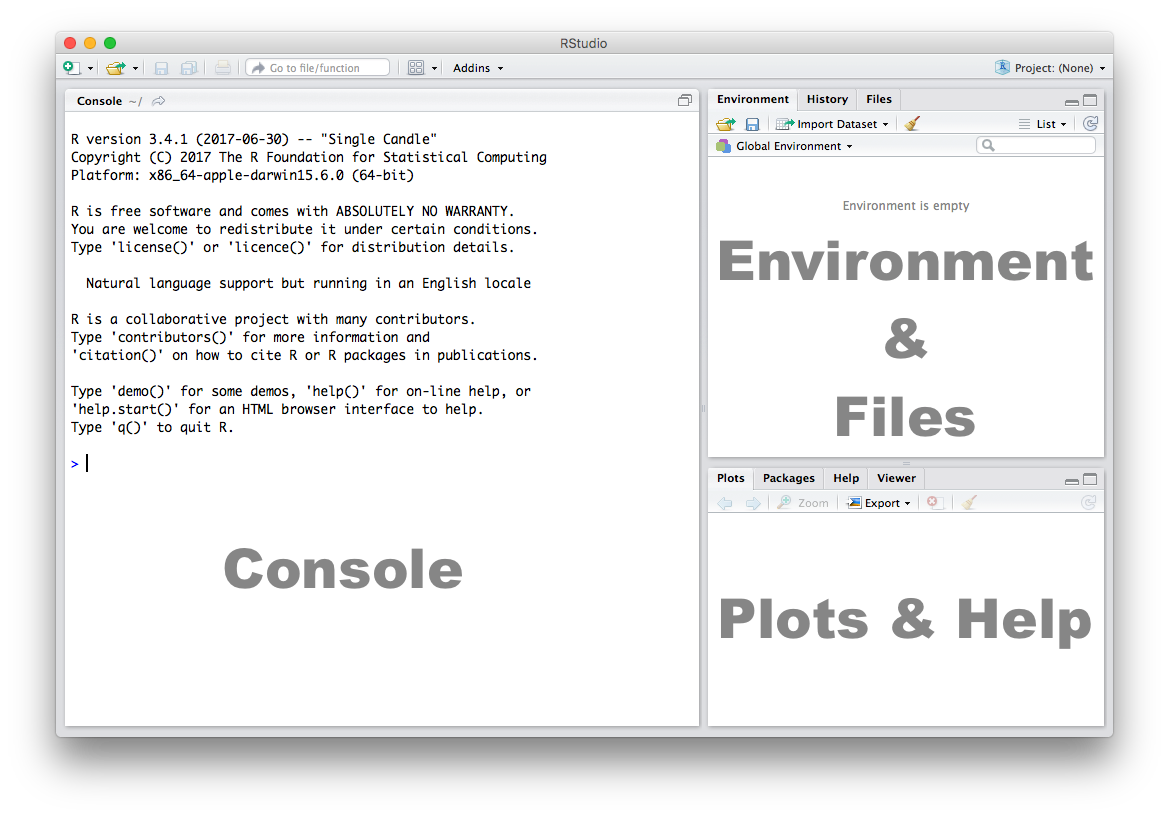
1.1.3 Courseware Setup
We’ll get started by typing the following at the console to install the courseware:
source("https://uclspp.github.io/PUBLG100/R/setup_courseware.R")When the setup app starts, press the Setup Courseware button to install the necessary files. If you run into any problems, you can click on the Help tab and send an error report.
If you’re unable to download the datasets using the setup app, you can manually download them from https://uclspp.github.io/datasets.
1.1.4 Console
The Console in RStudio is the simplest way to interact with R. You can type some code at the Console and when you press ENTER, R will run that code. Depending on what you type, you may see some output in the Console or if you make a mistake, you may get a warning or an error message.
Let’s familiarize ourselves with the console by using R as a simple calculator:
2 + 4[1] 6Now that we know how to use the + sign for addition, let’s try some other mathematical operations such as subtraction (-), multiplication (*), and division (/).
10 - 4[1] 65 * 3[1] 157 / 2[1] 3.5| You can use the cursor or arrow keys on your keyboard to edit your code at the console: - Use the UP and DOWN keys to re-run something without typing it again - Use the LEFT and RIGHT keys to edit |
 |
Take a few minutes to play around at the console and try different things out. Don’t worry if you make a mistake, you can’t break anything easily!
1.1.5 Functions
Functions are a set of instructions that carry out a specific task. Functions often require some input and generate some output. For example, instead of using the + operator for addition, we can use the sum function to add two or more numbers.
sum(1, 4, 10)[1] 15In the example above, 1, 4, 10 are the inputs and 15 is the output. A function always requires the use of parenthesis or round brackets (). Inputs to the function are called arguments and go inside the brackets. The output of a function is displayed on the screen but we can also have the option of saving the result of the output. More on this later.
1.1.6 Getting Help
Another useful function in R is help which we can use to display online documentation. For example, if we wanted to know how to use the sum function, we could type help(sum) and look at the online documentation.
help(sum)The question mark ? can also be used as a shortcut to access online help.
?sum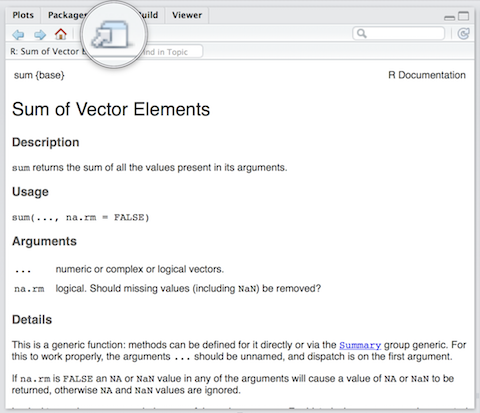
Use the toolbar button shown in the picture above to expand and display the help in a new window.
Help pages for functions in R follow a consistent layout generally include these sections:
| Desscription | A brief description of the function |
| Usage | The complete syntax or grammar including all arguments (inputs) |
| Arguments | Explanation of each argument |
| Details | Any relevant details about the function and its arguments |
| Value | The output value of the function |
| Examples | Example of how to use the function |
1.1.7 The Assignment Operator
Now we know how to provide inputs to a function using parenthesis or round brackets (), but what about the output of a function?
We use the assignment operator <- for creating or updating objects. If we wanted to save the result of adding sum(1, 4, 10), we would do the following:
myresult <- sum(1, 4, 10)The line above creates a new object called myresult in our environment and saves the result of the sum(1, 4, 10) in it. To see what’s in myresult, just type it at the console:
myresult[1] 15Take a look at the Environment pane in RStudio and you’ll see myresult there.
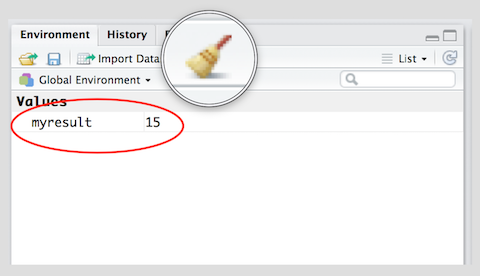
To delete all objects from the environment, you can use the broom button as shown in the picture above.
We called our object myresult but we can call it anything as long as we follow a few simple rules. Object names can contain upper or lower case letters (A-Z, a-z), numbers (0-9), underscores (_) or a dot (.) but all object names must start with a letter. Choose names that are descriptive and easy to type.
| Good Object Names | Bad Object Names |
|---|---|
| result | a |
| myresult | x1 |
| my.result | this.name.is.just.too.long |
| my_result | |
| data1 |
1.1.8 Sequences
We often need to create sequences when manipulating data. For instance, you might want to perform an operation on the first 10 rows of a dataset so we need a way to select the range we’re interested in.
There are two ways to create a sequence. Let’s try to create a sequence of numbers from 1 to 10 using the two methods:
- Using the colon
:operator. If you’re familiar with spreadsheets then you might’ve already used:to select cells, for exampleA1:A20. In R, you can use the:to create a sequence in a similar fashion:
1:10 [1] 1 2 3 4 5 6 7 8 9 10- Using the
seqfunction we get the exact same result:
seq(1, 10) [1] 1 2 3 4 5 6 7 8 9 10The seq function has a number of options which control how the sequence is generated. For example to create a sequence from 0 to 100 in increments of 5, we can use the optional by argument. Notice how we wrote by = 5 as the third argument. It is a common practice to specify the name of argument when the argument is optional.
seq(0, 100, by = 5) [1] 0 5 10 15 20 25 30 35 40 45 50 55 60 65 70 75 80
[18] 85 90 95 100Take a look at the help page for seq to see what other options are available.
help(seq)Now it’s your turn:
- Create a sequence of odd numbers between 0 and 100 and save it in an object called
odd_numbers
odd_numbers <- seq(1, 100, 2)- Next, display
odd_numberson the console to verify that you did it correctly
odd_numbers [1] 1 3 5 7 9 11 13 15 17 19 21 23 25 27 29 31 33 35 37 39 41 43 45
[24] 47 49 51 53 55 57 59 61 63 65 67 69 71 73 75 77 79 81 83 85 87 89 91
[47] 93 95 97 99What do the numbers in square brackets
[ ]mean? Look at the number of values displayed in each line to find out the answer.- Use the
lengthfunction to find out how many values are in the objectodd_numbers.- HINT: Try
help(length)and look at the examples section at the end of the help screen.
- HINT: Try
length(odd_numbers)[1] 501.1.9 Scripts
The Console is great for simple tasks but if you’re working on a project you would mostly likely want to save your work in some sort of a document or a file. Scripts in R are just plain text files that contain R code. You can edit a script just like you would edit a file in any word processing or note-taking application.
Create a new script using the menu or the toolbar button as shown below.
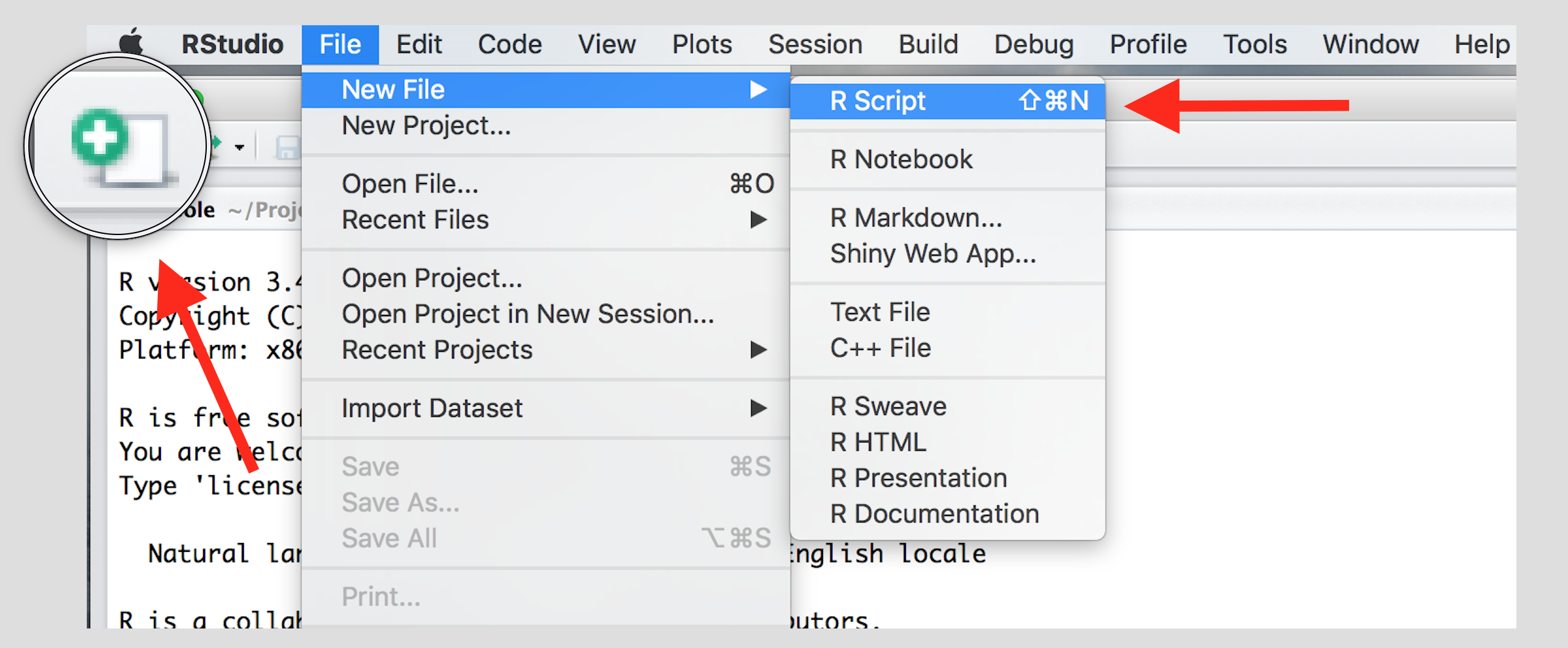
Once you’ve created a script, it is generally a good idea to give it a meaningful name and save it immediately. For our first session save your script as seminar1.R
| Familiarize yourself with the script window in RStudio, and especially the two buttons labeled Run and Source | 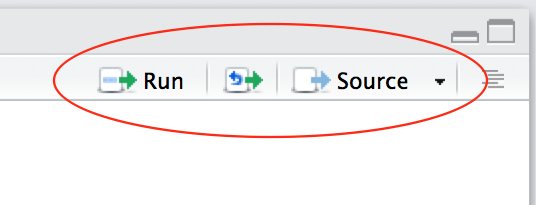 |
There are a few different ways to run your code from a script.
| One line at a time | Place the cursor on the line you want to run and hit CTRL-ENTER or use the Run button |
| Multiple lines | Select the lines you want to run and hit CTRL-ENTER or use the Run button |
| Entire script | Use the Source button |
1.1.10 data frames
A data frame is an object that holds data in a tabular format similar to how spreadsheets work. Variables are generally kept in columns and observations are in rows.
Although you can create a data frame manually, in most cases you will create a data frame by loading a dataset from a file. For now however, we will simply use a dataset that comes pre-installed with R.
Let’s take a look at a macroeconomic dataset called longley. The longley dataset is provided as a data frame of 7 variables and 16 observations.
help(longley)The help screen describes each of the 7 variables. Now let’s see what’s in the longley dataset.
longley GNP.deflator GNP Unemployed Armed.Forces Population Year Employed
1947 83.0 234.289 235.6 159.0 107.608 1947 60.323
1948 88.5 259.426 232.5 145.6 108.632 1948 61.122
1949 88.2 258.054 368.2 161.6 109.773 1949 60.171
1950 89.5 284.599 335.1 165.0 110.929 1950 61.187
1951 96.2 328.975 209.9 309.9 112.075 1951 63.221
1952 98.1 346.999 193.2 359.4 113.270 1952 63.639
1953 99.0 365.385 187.0 354.7 115.094 1953 64.989
1954 100.0 363.112 357.8 335.0 116.219 1954 63.761
1955 101.2 397.469 290.4 304.8 117.388 1955 66.019
1956 104.6 419.180 282.2 285.7 118.734 1956 67.857
1957 108.4 442.769 293.6 279.8 120.445 1957 68.169
1958 110.8 444.546 468.1 263.7 121.950 1958 66.513
1959 112.6 482.704 381.3 255.2 123.366 1959 68.655
1960 114.2 502.601 393.1 251.4 125.368 1960 69.564
1961 115.7 518.173 480.6 257.2 127.852 1961 69.331
1962 116.9 554.894 400.7 282.7 130.081 1962 70.551We can also look at the longley dataset graphically using the View function which displays the data frame like a spreadsheet.
View(longley)In order to access individual columns of a data frame we use the dollar sign $. For example, let’s see how to access the Year column
longley$Year [1] 1947 1948 1949 1950 1951 1952 1953 1954 1955 1956 1957 1958 1959 1960
[15] 1961 1962Often we want to access certain observations (rows) or certain columns (variables) or a combination of the two without looking at the entire dataset all at once. We can use square brackets to subset data frames. In square brackets we put a row and a column coordinate separated by a comma. The row coordinate goes first and the column coordinate second. So longley[10, 3] returns the 10th row and third column of the data frame. If we leave the column coordinate empty this means we would like all columns. So, longley[10,] returns the 10th row of the dataset. If we leave the row coordinate empty, R returns the entire column. longley[,3] returns the third column of the dataset.
longley[10, 3] # element in 10th row, 3rd column[1] 282.2longley[10, ] # entire 10th row GNP.deflator GNP Unemployed Armed.Forces Population Year Employed
1956 104.6 419.18 282.2 285.7 118.734 1956 67.857longley[, 3] # entire 3rd column [1] 235.6 232.5 368.2 335.1 209.9 193.2 187.0 357.8 290.4 282.2 293.6
[12] 468.1 381.3 393.1 480.6 400.7We can look at the first five rows of a dataset to get a better understanding of it with the colon in brackets like so: longley[1:5,]. We could display the second and fifth columns of the dataset by using the c() function in brackets like so: longley[, c(2,5)].
It’s your turn. Display all columns of the longley dataset and show rows 10 to 15. Next display all columns of the dataset and rows 4 and 7.
longley[10:15, ] # elements in 10th to 15th row, all columns GNP.deflator GNP Unemployed Armed.Forces Population Year Employed
1956 104.6 419.180 282.2 285.7 118.734 1956 67.857
1957 108.4 442.769 293.6 279.8 120.445 1957 68.169
1958 110.8 444.546 468.1 263.7 121.950 1958 66.513
1959 112.6 482.704 381.3 255.2 123.366 1959 68.655
1960 114.2 502.601 393.1 251.4 125.368 1960 69.564
1961 115.7 518.173 480.6 257.2 127.852 1961 69.331longley[c(4, 7), ] # elements in 4th and 7th row, all column GNP.deflator GNP Unemployed Armed.Forces Population Year Employed
1950 89.5 284.599 335.1 165.0 110.929 1950 61.187
1953 99.0 365.385 187.0 354.7 115.094 1953 64.9891.1.11 Plots
Now let’s create some plots from the longley dataset. First let’s create a scatterplot with the Year variable on the x-axis and Employed on the y-axis.
plot(longley$Year, longley$Employed)
To create a line plot instead, we use the same function with one additional argument type = "l".
plot(longley$Year, longley$Employed, type = "l")
Now it’s your turn.
- Use online help for the
plotfunction and find out how to create a plot that includes both points and lines.
plot(longley$Year, longley$Employed, type = "b")
1.1.12 Exercises
- Create a script and call it assignment01. Save your script.
- Download this cheat-sheet and go over it. You won’t understand most of it right a away. But it will become a useful resource. Look at it often.
- Calculate the square root of 1369 using the
sqrt()function. - Square the number 13 using the
^operator. - What is the result of summing all numbers from 1 to 100?
- Use the
names()function to display the variable names of thelongleydataset. - Use square brackets to access the 4th column of the dataset.
- Use the dollar sign to access the 4th column of the dataset.
- Access the two cells from row 4 and column 1 and row 6 and column 3.
- Using the
longleydata produce a line plot with GNP on the y-axis and population on the x-axis. - Use the help function to find out how to label the y-axis “wealth” and the x-axis “population”.
- Save your script, which should now include the answers to all the exercises.
- Source your script, i.e. run the entire script without error message. Clean your script if you get error messages.